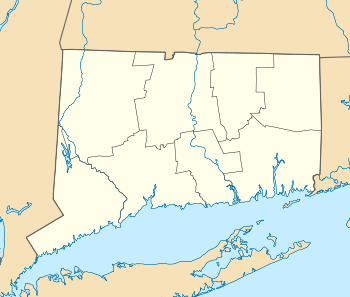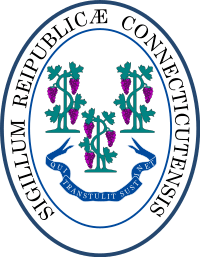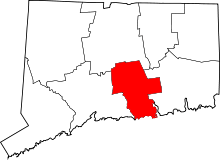Killingworth, Connecticut
| Killingworth, Connecticut | ||
|---|---|---|
| Town | ||
| ||
 Killingworth, Connecticut Location within the state of Connecticut | ||
| Coordinates: 41°22′50″N 72°34′35″W / 41.38056°N 72.57639°WCoordinates: 41°22′50″N 72°34′35″W / 41.38056°N 72.57639°W | ||
| Country | United States | |
| State | Connecticut | |
| NECTA | New Haven | |
| Region | Connecticut River Estuary | |
| Named | 1667 | |
| Government | ||
| • Type | Selectman-town meeting | |
| • First Selectman | Catherine Iino (D) | |
| • Selectman | Fred Dudek (R) | |
| • Selectman | Louis C. Annino, Jr. (D) | |
| Area | ||
| • Total | 35.8 sq mi (92.7 km2) | |
| • Land | 35.3 sq mi (91.5 km2) | |
| • Water | 0.5 sq mi (1.2 km2) | |
| Elevation | 390 ft (119 m) | |
| Population (2005)[1] | ||
| • Total | 6,403 | |
| • Density | 181/sq mi (70/km2) | |
| Time zone | UTC-5 (Eastern) | |
| • Summer (DST) | In) | |
| ZIP code | 06419 | |
| Area code(s) | 860 | |
| FIPS code | 09-40710 | |
| GNIS feature ID | 0213448 | |
| Website |
www | |
Killingworth is a town in Middlesex County, Connecticut, United States. The population was 6,455 as of July 1, 2015.
History

Killingworth was established from the area called Hammonasset, taken from the local Native American tribe of the same name. The area originally incorporated the town of Clinton, which were separated along ecclesiastical borders.[2][3] Part of New London County prior to May 1785, Killingworth was then included in the newly formed Middlesex County, where it remains today.
It was named after Kenilworth, England in honor of one of the first settlers, Edward Griswold.[3] Kenilworth's name was more similar to "Killingworth" during the American colonial period, and over time the pronunciation and spelling drifted towards the modern one.[2] Coincidentally, there is a town and village in England called Killingworth and Killingworth Village in the county of Tyne and Wear, which do not seem to have any connection with Killingworth, Connecticut.
In the late 17th century, Killingworth became the birthplace of what would eventually become Yale University. The Rev. Abraham Pierson, the college's first president, taught some of the first classes in his Killingworth home - which is actually in present-day Clinton, Connecticut. However, in 1701, the college's first official home was constructed in Old Saybrook on the peninsula known as Saybrook Point. Eventually the school was moved to its present-day home in New Haven.[4]
Geography
According to the United States Census Bureau, the town has an area of 35.8 square miles (93 km2). Of this total, 35.3 square miles (91 km2) is dry land and 0.5 square miles (1.3 km2) – or 1.34% – is water-covered.
Killingworth also contains Chatfield Hollow State Park.
Demographics
| Historical population | |||
|---|---|---|---|
| Census | Pop. | %± | |
| 1820 | 2,342 | — | |
| 1850 | 1,107 | — | |
| 1860 | 1,126 | 1.7% | |
| 1870 | 856 | −24.0% | |
| 1880 | 748 | −12.6% | |
| 1890 | 582 | −22.2% | |
| 1900 | 651 | 11.9% | |
| 1910 | 660 | 1.4% | |
| 1920 | 531 | −19.5% | |
| 1930 | 482 | −9.2% | |
| 1940 | 1,230 | 155.2% | |
| 1950 | 677 | −45.0% | |
| 1960 | 1,098 | 62.2% | |
| 1970 | 2,435 | 121.8% | |
| 1980 | 3,976 | 63.3% | |
| 1990 | 4,814 | 21.1% | |
| 2000 | 6,018 | 25.0% | |
| 2010 | 6,525 | 8.4% | |
| Est. 2014 | 6,490 | [5] | −0.5% |
| U.S. Decennial Census[6] | |||
As of the census[7] of July 1, 2015, there were 6,455 people, 2,513 households, and 1,765 families residing in the town. The population density was 184.7 people per square mile (65.8/km²). There were 2,598 housing units at an average density of 70.6 per square mile (24.9/km²). The racial makeup of the town was 96.4% White, 0.7% African American, 0.2% Native American, 1.1% Asian, 0.1% Native Hawaiian and Other Pacific Islander, 2.2% Hispanic or Latino, and 1.3% Two or More Races.
There were 2,513 households with a 95.3% occupancy rate out of which 23.9% had children under the age of 18 living with them, 73.8% were married couples living together, 4.3% had a female householder with no husband present, and 19.6% were non-families. 16.1% of all households were made up of individuals and 8.0% had someone living alone who was 65 years of age or older. The average household size was 2.74 and the average family size was 3.08.
In the town, the population was spread out with 4% under the age of 5, 23.9% under the age of 18, 3.6% from 18 to 24, 29.4% from 25 to 44, 28.0% from 45 to 64, and 16% who were 65 years of age or older. The median age was 40 years. For every 100 females, there were 98.4 males. For every 100 females age 18 and over, there were 96.8 males.
The median income for a household in the town was $112,137. The per capita income for the town was $48,537. None of the families and 1.7% of the population were living below the poverty line, including no under eighteens and 1.4% of those over 64.
| Voter Registration and Party Enrollment as of October 25, 2005[8] | |||||
|---|---|---|---|---|---|
| Party | Active Voters | Inactive Voters | Total Voters | Percentage | |
| Republican | 1,149 | 17 | 1,166 | 25.28% | |
| Democratic | 892 | 8 | 900 | 19.51% | |
| Unaffiliated | 2,511 | 33 | 2,544 | 55.15% | |
| Minor Parties | 3 | 0 | 3 | 0.07% | |
| Total | 4,555 | 58 | 4,613 | 100% | |
Government
Killingworth is governed by a Board of Selectmen, currently headed by First Selectman, Democrat Cathy Iino, with Fred Dudek and Louis Annino Jr also on the board.[9]
Education
Students attending school in Killingworth are a part of Connecticut's Regional School District #17, which consists of Haddam and its villages of Haddam Neck (located on the eastern bank of the Connecticut River) and Higganum. The high school is called Haddam-Killingworth High School (often abbreviated as simply "HK"), and is located in Higganum. The school's sports teams are called the 'Cougars'. The middle-school, Haddam Killingworth Middle School, or "HKMS", was built in Killingworth in 2006 and houses grades 5 through 8.
Transportation
The Estuary Transit District provides public transportation throughout Killingworth and the surrounding towns through its 9 Town Transit Service. Services include connections to the Old Saybrook Train Station, served by Amtrak and Shoreline East railroads.
Popular culture
The town was the subject of the poet Henry Wadsworth Longfellow's poem "The Birds of Killingworth" published in Tales of a Wayside Inn.
1999: The largest tree in Rockefeller Center history, 100 feet (30 m) high, was chosen from Killingworth, CT.
Notable people
- Jeff Bagwell, Hall of Fame Major League Baseball player for the Houston Astros, lived in Killingworth.
- Carleton Beals, radical American journalist, author, historian, and a crusader with special interests in Latin America.[10]
- Abel Buell, publisher of the first map of the new United States created by an American, was born in Killingworth.[11]
- Jonathan Bush, American banker, brother of President George H. W. Bush and the uncle of President George W. Bush.[12]
- Titus Coan, missionary to Hawai'i (then the Sandwich Islands) in the 1800s.
- Silas Halsey, former US Congressman
- Haynes Johnson, Pulitzer Prize–winning journalist, best-selling author and political analyst, lived in Killingworth.
- Ricki Lake, former host of Ricki Lake, former contestant for Dancing With The Stars, and now host of The Ricki Lake Show lived in Killingworth in the late 1990s.
- Hugh Lofting, author of the Doctor Dolittle series.
National Historic Sites
- Emmanuel Church, added August 5, 1999
- Oak Lodge, added September 4, 1986
- Parmelee House (Killingworth, Connecticut).
References
- ↑ "U.S. Census Bureau Population Estimates". census.gov. Archived from the original on 2011-06-29. Retrieved 11 April 2018.
- 1 2 Killingworth Historical Society Archived 2008-10-12 at the Wayback Machine.
- 1 2 Town of Killingworth Historical Sign, 1981
- ↑ "Archived copy". Archived from the original on 2008-10-12. Retrieved 2007-09-09.
- ↑ "Annual Estimates of the Resident Population for Incorporated Places: April 1, 2010 to July 1, 2014". Archived from the original on May 23, 2015. Retrieved June 4, 2015.
- ↑ "Census of Population and Housing". Census.gov. Archived from the original on May 12, 2015. Retrieved June 4, 2015.
- ↑ "American FactFinder". United States Census Bureau. Retrieved 2008-01-31.
- ↑ "Registration and Party Enrollment Statistics as of October 25, 2005" (PDF). Connecticut Secretary of State. Archived from the original (PDF) on September 23, 2006. Retrieved 2006-10-02.
- ↑ "Town of Killingworth". www.townofkillingworth.com. Retrieved 11 April 2018.
- ↑ United States. Congress. Senate. Committee on the Judiciary (11 April 1961). "Fair Play for Cuba Committee. Hearings before the Subcommittee to Investigate the Administration of the Internal Security Act and Other Internal Security Laws of the Committee on the Judiciary, United States Senate, Eighty-seventh Congress, first session ." Washington, U.S. Govt. Print. Off. Retrieved 11 April 2018 – via Internet Archive.
- ↑ "Archived copy". Archived from the original on 2008-05-14. Retrieved 2008-06-03.
- ↑ CounterPunch; "Pioneer" list - See CounterPunch for main website
http://www.robinsonlibrary.com/decorative/metalwork/buell.htm
External links
- Town government web site
- Regional School District #17
- Local news site
- Chamber of Commerce site
- United States Census Bureau[1]
- ↑ "Population estimates, July 1, 2016, (V2016)". www.census.gov. Retrieved 2017-03-08.

